What are the Fastest Growing Cities in the UK?
Fast-growing cities can make a good property investment for several reasons: Fast-growing cities have a high demand for property to buy and property to rent, with demand frequently exceeding supply. That means price rises, rents and yields offer good potential for property investors. Fast-growing cities also tend to have successful economies and successful businesses which offer good, well-paid jobs. That attracts more people to live and work in them and helps create a buoyant property market.
Here we will look at the 20 fastest-growing cities in the UK.
1. Milton Keynes

Created as a new town in the 1960s Milton Keynes has grown fast ever since – and keeps on expanding. It’s is a hotspot for business and job growth and scores highly on the quality of life for its residents. Over the last decade, Milton Keynes has proved to be one of the best performing places in the UK for job growth, earnings and other indicators of economic success.
- The local economy is worth approximately £13,900m GVA.
- There has been economic growth of 2.1% year on year.
- The population is forecast to grow from 268,607 in 2018 to 294,707 in 2028.
- Jobs growth of 1.3% year-on-year – 13th largest in the UK.
- The current average house price is £264,265 – 3.9% annual growth.
- Some estimates suggest Milton Keynes could be a city of 500,000 people, within the next 30 years.
2. Reading

Reading in Berkshire has some of the best transport links in the country being right on the motorway network, within easy reach of Heathrow Airport and with frequent trains into central London. Reading is at the heart of the M4 Corridor area and is a centre for IT, telecoms, tech. and digital businesses with many global corporations based in and around the area.
- The local economy is worth approximately £7,800m GVA.
- There has been economic growth of 2.0% year-on-year.
- The population is forecast to grow from 163,203 in 2018 to 173,496 in 2028.
- Jobs growth of 0.2% year-on-year – 120,700 jobs in total.
- The current average house price is £276,130 – -5.4% annual change.
- The new trans-London Elizabeth Line (Crossrail) will put Reading within 50 minutes of the City of London.
3. Oxford

Oxford is a world-famous academic centre and best known for The University of Oxford. However, it also has one of the UK’s most successful city economies including high added value ones such as health, education, research, technology and publishing.
Oxford also has manufacturing industry with the Mini Plant Oxford and is a major tourist destination. Such is the demand for housing in the area that the Oxfordshire Growth Board has secured £215m of Government investment to contribute towards the provision of new homes and infrastructure across Oxfordshire. This will support the ambition to build 100,000 new homes across Oxfordshire up until 2031.
- The local economy is worth approximately £8,000m GVA.
- There has been economic growth of 1.8% year-on-year.
- The population is forecast to grow from 154,327 in 2018 to 156,102 in 2028.
- Jobs growth of 4% year-on-year – 4th largest in the UK.
- The current average house price is £395,746 – -3.1% annual change.
- Oxford is one of the UK’s most expensive cities for housing. Only Cambridge and London have more expensive average house prices.
4. Peterborough

Peterborough is a new town first created in 1967 to take the overspill from London and has grown fast ever since. Thousands of new jobs have been created and thousands of new houses built here. Advanced engineering and manufacturing, agri-tech, food and drink, digital and creative, energy and environment, and financial services are important industries.
Peterborough City Council says Peterborough is the country’s fifth fastest-growing city and needs 19,400 more houses by 2036.
- The local economy is worth approximately £6,400m GVA.
- There has been economic growth of 1.7% year-on-year.
- The population is forecast to grow from 201,041 in 2018 to 214,800 in 2028.
- Jobs growth of 1.2% year-on-year – 16th largest in the UK.
- The current average house price is £197,118 – 3.7% annual growth.
- Peterborough benefits from excellent access to London by train (up to five direct trains per hour taking as little as 50 minutes) and the A1(M) motorway.
5. Cambridge
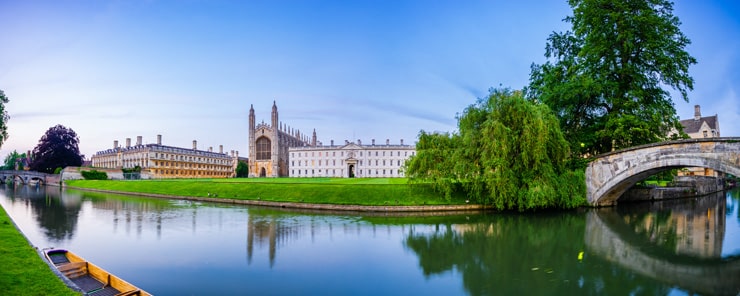
Cambridge is world-famous for the University of Cambridge and around one in five residents are students. Thanks to the university-led science parks located here Cambridge is also a world leader in futuristic industries like software, research and development, pharmaceuticals and biotechnology which provide lots of highly qualified and well-paid jobs and support the buoyant local economy.
It’s also a tourist hotspot, popular with overseas tourists, and attracts over half a million visitors a year.
Cambridge has some of the UK’s highest average house prices.
- The local economy is worth approximately £9,500m GVA.
- There has been economic growth of 1.7% year-on-year.
- The population is forecast to stay broadly level at 125,758 in 2018 and 125,576 in 2028.
- Jobs growth of 2.2% year-on-year – 2nd largest in the UK.
- The current average house price is £413,243 – -1.6% annual change.
- DNA was first identified in Cambridge. It is also said that association football was invented in Cambridge too.
6. Southampton
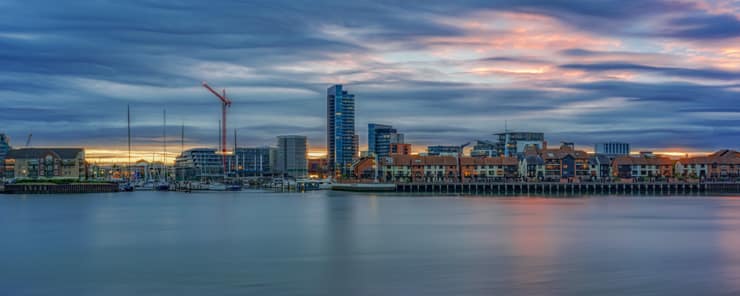
Southampton is one of the UK’s main maritime cities and, together with nearby Portsmouth and South Hampshire, one of the largest metropolitan areas with a population of around 1.5 million people.
It is the UK’s second-largest container port, a major vehicle export centre, a ferry terminal and Europe’s largest cruise ship terminal. Other industries include oil refining, chemicals and the public sector.
- The local economy is worth approximately £7,400m GVA.
- There has been economic growth of 1.7% year-on-year.
- The population is forecast to grow from 252,796 in 2018 to 267,649 in 2028.
- Jobs growth of 0.7% year-on-year – 152,500 jobs in total.
- The current average house price is £199,660 – -4.0% annual change.
- With prices approximately around the national average Southampton ranks as one of the cheaper places to invest in property in the south of the UK.
7. Ipswich

Ipswich is the county town of Suffolk. It’s a historic town with an ancient port and a one-time agricultural centre. Today Ipswich’s main industries are services, including financial services, but the nearby Port of Felixstowe is the UK’s busiest container port and one of the Ipswich area’s main employers.
- The local economy is worth approximately £4,900m GVA.
- There has been economic growth of 1.6% year-on-year.
- The population is forecast to grow from 137,532 in 2018 to 146,892 in 2028.
- Jobs growth of 0.8% year-on-year – 82,600 jobs in total.
- The current average house price is £197,722 – 0.8% annual growth.
- Ipswich has some of the lowest property prices in the east of England, with average prices well below the national average.
8. Exeter
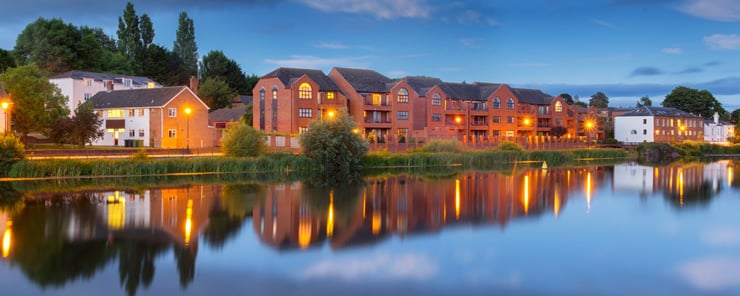
Exeter in Devon has grown fast in recent decades. The economy is based around emerging knowledge-based industries and includes public services, health, education, retail, distribution, research and development, tech and the STEMM sector.
Exeter has the sixth-highest employment level in the country. This has helped attract more people to come and live and work in Exeter and created a high demand for property to buy and property to rent.
The University of Exeter is also one of the UK’s top universities with around 22,000 students.
- The local economy worth is approximately £5,200m GVA.
- There has been economic growth of 1.5% year on year.
- The population is forecast to grow from 130,428 in 2018 to 140,131 in 2028.
- Jobs growth of 1.6% year-on-year – 9th most prominent in the UK.
- The current average house price is £261,164 – 0.8% annual growth.
- Exeter has a Liveable City Plan – a 20-year vision to expand local infrastructure and build 12,000 new houses.
9. Birmingham

Birmingham was the one-time ‘workshop of the world’, a major centre for manufacturing. It’s now a very significant commercial centre and professional services like banking, finance and law are major employers here.
Building on its manufacturing heritage Birmingham is also strong in high tech. manufacturing too, and new, emerging industries like connected-and-autonomous vehicles or CAV technology, which could be massive in future. Birmingham is also one of the UK’s largest university cities with around 80,000 students at five universities.
- The local economy is worth approximately £27,900m GVA.
- There has been economic growth of 1.5% year-on-year.
- The population is forecast to grow from 1.14m in 2018 to 1.22m in 2028.
- Jobs growth of 1.2% year-on-year – 18th largest in the UK.
- The current average house price is £185,449 – -0.5% annual change.
- The future HS2 high-speed railway will put Birmingham just 49 minutes from London and a new city district will be built around the new HS2 station.
10. London
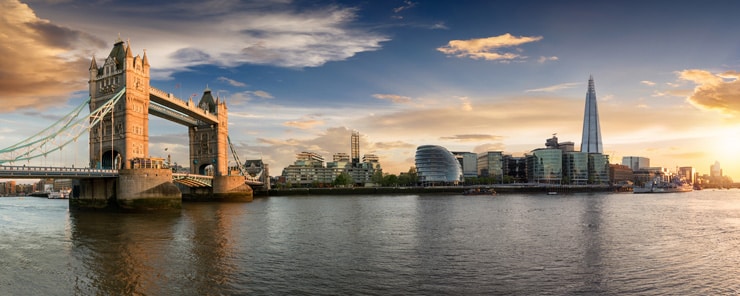
Nobody will be surprised to find London is one of the fastest-growing cities in the UK.... although they may be surprised to find that it only ranks number ten according to GVA growth.
But London already has a combined GVA over 60 times larger than the fastest growing city in this report. London is one of only two Alpha++ cities in the world, an index which ranks global cities according to their city economics.
The only other comparable Alpha++ city in the world is New York.
- The local economy is worth approximately £864,600m GVA (London, Inner London & Outer London combined).
- There has been economic growth of 1.4-1.5% year on year.
- It is estimated that London’s population could reach 9.54 million in 2026 and 10.11 million in 2036.
- Jobs growth up to 2.1% year-on-year – 3rd largest in the UK (Inner London).
- The current average house price is £474,660 – 1.2% annual growth (all London average).
11. Bristol
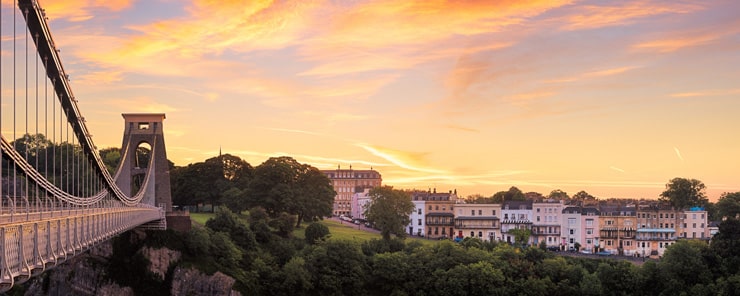
Bristol is already one of the ten biggest cities in the UK. As well as a growing population this report says Bristol is becoming one of the best cities in the whole of Europe for jobs growth too. Growing industries here include financial services, IT, creative and media, digital and tech. – Bristol is a tech. ‘super-cluster’.
Bristol is a major student city too so has a huge student accommodation market. There are four universities here with around 50,000 students altogether.
- The local economy is worth approximately £14,100m GVA.
- There has been economic growth of 1.4% year-on-year.
- The population is forecast to grow from 463,405 in 2018 to 505,964 in 2028.
- Jobs growth of 1% year-on-year – 353,200 jobs in total.
- The current average house price is £285,296 – 1.8% annual growth.
- There are ambitious plans to expand Bristol with a new city centre suburb of 11,000 homes to be called Temple Quarter, and a new garden suburb at Filton called Brabazon is underway.
12. Portsmouth
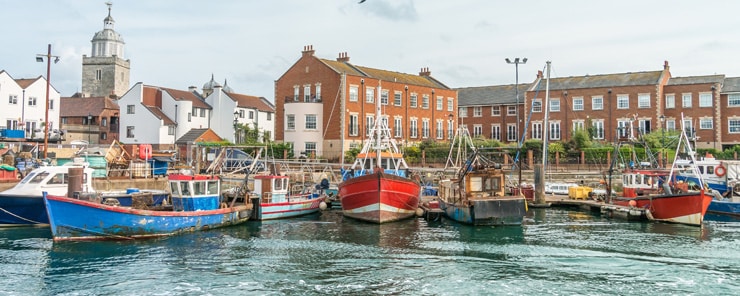
Portsmouth is a city of the sea. Portsmouth is one of the country’s biggest commercial ports, a busy ferry terminal with links to France, Spain and elsewhere and is the home of the Royal Navy too. Portsmouth is already the most densely populated city in the UK after London. Portsmouth could become an even larger city in the future as there are plans to build a new Portsmouth suburb with 4,000 new homes on reclaimed land at Tipner West and Horsea Island.
- The Local economy is worth approximately £5,400m GVA.
- There has been economic growth of 1.4% year-on-year.
- The population is forecast to grow from 215,133 in 2018 to 225,426 in 2028.
- Jobs growth of 0.5% year-on-year – 114,700 jobs in total.
- The current average house price is £212,171 – 0.3% annual growth.
- Portsmouth is located on Portsea Island making it Britain’s only island city. The limited supply of land for building keeps the property market here buoyant.
13. Derby

Derby is one of the UK’s main manufacturing cities and a major contributor to the UK’s exports. This report says that Derby exports more goods and services per job than any other in Britain. Big names in Derby include aero-engine manufacturer Rolls Royce, train manufacturers Bombardier Transportation and car manufacturers Toyota Motor Manufacturing. Derby is a particularly well-connected city with good road and rail links and is close to the East Midlands Airport, one of the country’s biggest air freight airports. There will also be an HS2 high-speed railway station near Derby at Toton.
- The local economy is worth approximately £6,800m GVA.
- There has been economic growth of 1.4% year-on-year.
- The population is forecast to grow from 257,174 in 2018 to 269,783 in 2028.
- Jobs growth of 1% year-on-year – 148,700 jobs in total.
- The current average house price is £159,403 – 0.3% annual growth.
- Derby has low property prices for a major city which are around a third cheaper than the national average.
14. Manchester

Greater Manchester, including the City of Manchester itself, is one of the largest economic areas and one of the most heavily populated areas outside of London. Known for being the one-time capital of cotton manufacturing – or Cottonopolis – it’s now a centre for modern, emerging industries including professional services, digital, media and tech.
There’s been a huge amount of regeneration and development in and around Manchester in recent years including several high-rise skyscrapers. Many more residential and commercial developments are underway or planned here. Manchester is one of the largest student cities not just in the UK but in the whole of Europe, with around 100,000 students.
- The Local economy is worth approximately £21,600m GVA.
- There has been economic growth of 1.3% year-on-year.
- The Population is forecast to grow from 541,000 (City of Manchester) in 2018 to 625,000 in 2028.
- Jobs growth of 1.5% year-on-year – 10th largest in the UK.
- The current average house price is £183,234 – 1.9% annual growth.
- Manchester property prices have risen sharply in recent years but are still around 25% less than the national average and more than 50% lower than in London.
15. Swindon

Swindon is the largest town in Wiltshire and its main service centre. Swindon benefits from good access to the M4 motorway and from being right in the Great Western mainline railway. A one-time railway town its main industries include manufacturing (although the Honda car manufacturing plant here is scheduled for closure), logistics, distribution, financial services, pharmaceuticals and research.
- The local economy is worth approximately £9,200m GVA.
- There has been economic growth of 1.3% year-on-year.
- The population is forecast to grow from 221,966 in 2018 to 233,666 in 2028.
- Jobs growth of 0.9% year-on-year – 120,900 jobs in total.
- The current average house price is £214,119 – -0.8% annual change.
- Swindon is home to the Magic Roundabout, said to be Britain’s scariest road junction!
16. Brighton
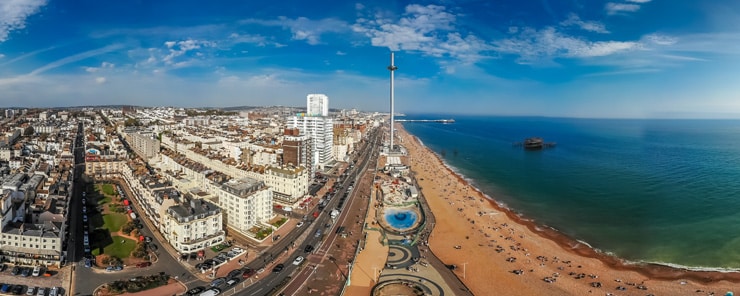
Brighton is well known as a seaside resort. It is a top ten UK tourist and visitor destination with around 490,000 visits a year which are an important part of the economy here. Brighton is also an important business and commercial city with key employers including financial services, media and creative industries and tech.
This report says that Brighton is one of the top UK cities for business. Brighton is also highly regarded for its quality of life and culture. Sometimes nicknamed ‘London on Sea’ it is a popular location for second homes with those who live in London and also London commuters – which also keeps Brighton property prices and rents buoyant.
- The local economy is worth approximately £8,000m GVA.
- There has been economic growth of 1.2% year-on-year.
- The population is forecast to grow from 290,395 in 2018 to 307,939 in 2028.
- Jobs growth of 1.2% year-on-year – one of the top 20 for jobs growth.
- The current average house price is £368,224 – -0.1% annual change.
- Brighton and nearby Hove are combined as a city and more correctly known as the city of Brighton and Hove.
17. Bournemouth

Bournemouth is one of the country’s most popular tourist resorts with an estimated 4.7m tourist visits a year. Other industries in Bournemouth, as well as nearby Christchurch and Poole, include health, education, the public sector, retail, financial services and tech. – Bournemouth is one of the UK’s new emerging centres for tech. Bournemouth is also a student centre with around 16,000 students at Bournemouth University, plus thousands of foreign students who learn English at the English language schools here. Bournemouth is also a popular spot for retirees and holiday property.
- The local economy is worth approximately £4,900m GVA.
- There has been Economic growth of 1.2% year-on-year.
- The population is forecast to grow from 395,784 in 2018 to 420,833 in 2028.
- Jobs growth of 1.2% year-on-year – one of the top 20 for jobs growth.
- The current average house price is £251,725 – -0.1% annual change.
- Bournemouth property prices are higher than many other UK cities but still only at around the national average.
18. Leicester

Leicester has an industrial past as a manufacturing centre for footwear, hosiery and textiles …. it used to be said that Leicester clothes the world. Today it has a strong, modern economy based on light manufacturing, services and distribution. Big companies here include Next, Sytner Group, Dunelm and Walkers who operate the largest crisp factory in the world. The University Hospitals of Leicester NHS Trust is one of the biggest in the country. Almost 40,000 students study at the University of Leicester and De Montfort University.
- The local economy is worth approximately £8,000m GVA.
- There has been economic growth of 1.2% year-on-year.
- The population is forecast to grow from 355,218 in 2018 to 380,265 in 2028.
- Jobs growth of 0.5% year-on-year – 205,400 jobs in total.
- The current average house price is £177,556 – 3% annual growth.
- The "Good Growth for Cities" report from consultants PwC and Demos has said that Leicester’s economy is one of the top ten strongest in the country – right up there with Oxford.
19. Norwich

Norwich is a historic city, the county town of Norfolk and the unofficial capital of East Anglia.
Originally known for textiles and Colman’s Mustard main Norwich employers are now business and financial services, public services, retail and light manufacturing, tech. and research.
Norwich is an important centre for research-based around the Norwich Research Park next to the University of East Anglia. Norwich scores highly for its quality of life and offers easy access to the Norfolk countryside and coast and the Norfolk Broads, a popular tourist area.
- The local economy is worth approximately £3,000m GVA.
- There has been economic growth of 1.2% year-on-year.
- The population is forecast to grow from 141,437 in 2018 to 148,919 in 2028.
- Jobs growth of 0.6% year-on-year – 136,200 jobs in total.
- A current average house price of £202,582 – -2.3% annual change.
- Norwich house prices are cheaper than much of surrounding Norfolk and are well under the national average.
20. Aberdeen
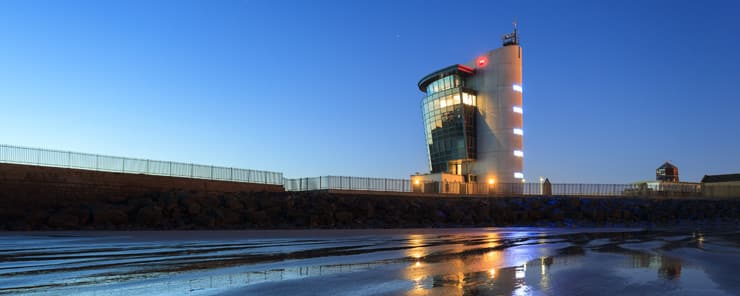
Aberdeen is very much the oil capital of the UK and is the largest centre for the petroleum industry anywhere in Europe. Aberdeen is the main service centre for the North Sea oil and gas fields. As well as global oil companies who have a presence here Aberdeen is home to hundreds of other companies who support the oil and gas industry and thousands of employees who work in it. As a result, Aberdeen is one of the most economically successful and prosperous parts of Scotland.
- The Local economy is worth approximately £11,600m GVA.
- There has been economic growth of 1.2% year-on-year.
- The population is forecast to grow from 227,560 in 2018 to 238,126 in 2028.
- Jobs growth of 0.3% year-on-year – 177,900 jobs in total.
- The current average house price is £144,553 – -3.5% annual change.
- Aberdeen property prices tend to reflect the fortunes of the oil industry, appreciating most when oil prices are buoyant.
About Our Data
Average house prices are from the latest HM Land Registry UK House Price Index England.
Population estimates are from the latest ONS Overview of the UK Population.
